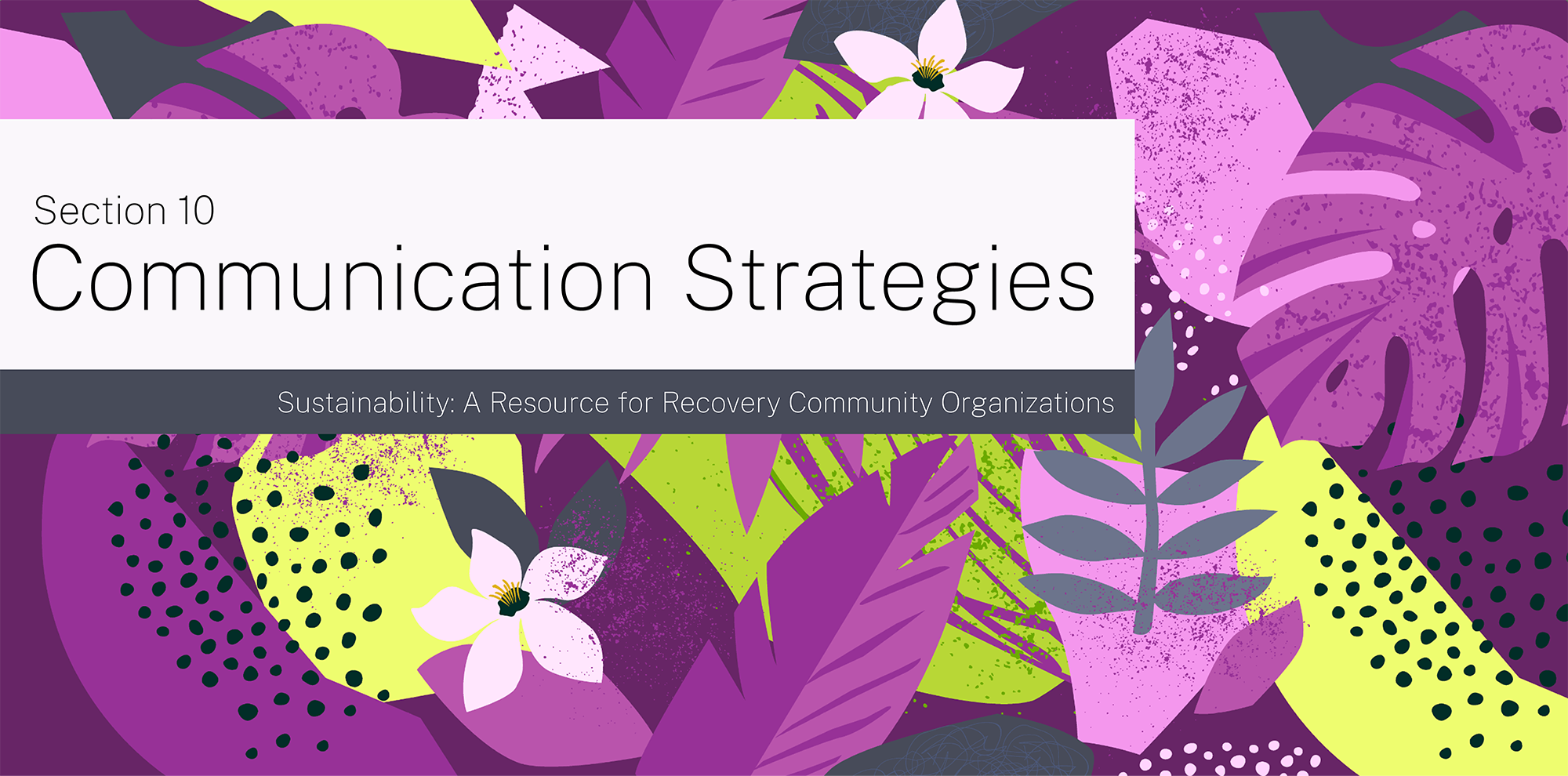
Section 10: Communication Strategies
This section focuses on the basic structures, tools, and systems many nonprofits use to communicate.
Communication with stakeholders, be it via marketing and social media, newsletters, an organization's website, or direct messages to participants or volunteers, is critical for an RCO's sustainability. Although they're often under-supported and unplanned, these communication practices can greatly influence an organization's strength and longevity.
As a leader, ask yourself these questions as you move through the Section:
- How do we currently communicate with our communities, audience, and other stakeholders? How can we make our current processes more efficient or less cumbersome?
- How do folks want to hear from us and about us? What are the right communication pathways for our work?
- How far do we want to reach? If we’re happy with our current size, maybe we don’t need to worry about significantly expanding our processes…
Developing Communication Strategies
When developing communication strategies, RCOs should ensure that their messaging is accessible and resonates with a diverse audience. This means not only addressing language barriers but also considering cultural relevance and the varied ways different groups access and process information. Communication strategies should be regularly evaluated and adjusted to ensure they effectively reach and engage all segments of the community, taking into account the different social determinants that affect health equity.
Effective Communication and Engagement with Diverse Stakeholder Groups
Effectively communicating and engaging with different stakeholder groups involves understanding and addressing the diverse ways people receive and process information. This means not only providing information in multiple languages but also considering literacy levels, cultural nuances, and preferred communication channels (e.g., community meetings, social media, local newsletters). To avoid unintentionally excluding groups, RCOs should assess their current communication methods and seek feedback on their effectiveness. Training staff in cultural competency and inclusive communication practices can also help ensure that engagement strategies are as broad-reaching and inclusive as possible.
Branding
Branding is crucial for RCOs as it helps create a strong identity, builds trust, and communicates the organization's mission. The RCO’s branding is a way to elevate recovery, bust stigma, promote multiple pathways, and educate the public about recovery. Through thoughtful branding, an RCO can communicate its mission and values more powerfully, inspiring people to engage with and support its cause. A strong brand can also dispel misconceptions and stigma associated with substance use and recovery, fostering a more inclusive and accepting environment. Also, it can highlight the diverse pathways to recovery, demonstrating that there is no one-size-fits-all approach. By presenting a positive image of recovery, the RCO's branding can help to create wider opportunities for those in recovery within their community.
Here are some key things an RCO should consider when it comes to branding:
- Mission and Values Alignment: Make sure your branding matches what your RCO stands for and its goals.
- Know your Audience: Understand who you want to reach and what they like. Make your branding appealing to them.
- Consistency: Use the same logo, colors, fonts, and images everywhere.
Read Adobe’s article Create a brand style guide to ensure consistent brand identity to learn about creating a style guide for your RCO.
- Logo and Visual Identity: Develop a memorable logo that visually represents the RCO's mission. Also, create a clear style for all your RCO’s designs.
- Clear Messaging: Make your message clear and interesting. Tell people about your mission, what you've achieved, and why you're unique.
- Storytelling: Share emotional stories that show the good work you're doing.
- Transparency and Trust: Be honest about what you do, how you use money, and what you've achieved to build trust. Share your annual report detailing how funds are used and the impact of their work.
- Social Media and Digital Presence: Use your branding on your website, social media, emails, and other online places.
- Staff and Volunteer Training: Teach your staff and volunteers about your branding and why it's important to keep it consistent.
- Know How People See You: Keep an eye on how your brand is doing and what people are saying about it. Collect and use feedback to improve your branding. For instance, if a survey reveals that the public perceives your brand as “outdated”, you might decide to modernize your logo and website design.
Resources: See The Role of Brand in the Nonprofit Sector from Stanford SOCIAL INNOVATION Review and 7 Essential Tips for Building a Strong Nonprofit Brand from Donorbox to learn more about the importance of building and maintaining a brand for your RCO.
Website Fundamentals
Is our website providing visitors the information, access, and resources we intend?
For a lot of RCOs, stepping into the online world begins with social media, especially Facebook. It's an easy way to keep in touch with your community, share news, and start making a name for your RCO online. A Facebook page is also a great way to reach more people, and is a key part of any online marketing plan.
Once you've got the hang of Facebook, you can start to grow your online presence even more. This is where the idea of building a website comes in. Having a website lets you show your RCO in a more personal and professional way. It's about creating a space where your RCO can connect with its members, promote its activities, and build its reputation. It allows you to reach a wider audience, engage with them in meaningful ways, and foster a sense of community. While a Facebook page is a great starting point, it's essential to consider other platforms and strategies, such as websites, blogs, and other social media channels, to fully leverage the potential of the digital space.
When starting to develop or redesign your RCO’s website, think through these essential components that are rooted in the National Standards for Recovery Community Organizations.
- Show that you're a non-profit.
- Highlight your recovery leadership team.
- Make it clear you mainly focus on recovery from substance use disorders.
- Explain how people can get involved through volunteering and events.
- Talk about special projects and groups that enhance participation of recovery voices, like town hall meetings, Peer Advisory Councils, board of directors, and volunteer opportunities.
- Describe the peer recovery support services you offer, who provides them, and how to access them.
- Show that you support all types of recovery and support people who use drugs and/or alcohol.
- Highlight how you support the diverse needs of underrecognized and historically marginalized people in your community through your staff and board representation, activities, advocacy, and programs.
- Show that you understand the impact of stigmatizing language and work to reduce stigma through your website, blogs, social media, and marketing materials.
- Show that you aim to meet high ethical standards and treat everyone with dignity and equity, through an easy-to-find code of ethics and grievance policies.
In addition to the RCO standards, keep these simple rules in mind for your website:
- Make sure your RCO's goals and reasons for existing are easy to understand on the homepage. Visitors should quickly get what your RCO is about and the difference you're trying to make. On other pages, tell the story of your RCO and how it's helping the community.
- Make your contact details easy to find. This includes email and physical addresses, phone numbers, and a contact form. These should be easy to find for different reasons, like asking about programs, giving donations, or getting in touch with the leaders of the RCO.
- Your website should be easy to use and understand. It should be easy to find what you're looking for, and information should be sorted in a way that makes sense. This makes sure the website can be used by everyone, no matter their abilities. Take a look at resources from the ADA for Guidance on Web Accessibility on making your website accessible.
- Make sure your website works well on phones and tablets. A lot of people use these devices to go online, so it's important your website looks good and works well on them.
An RCO might want to share more information or encourage certain actions through its website. This could include asking for donations, promoting calls to action, encouraging people to sign up for a mailing list, or highlighting volunteer opportunities. Ensure that all these elements are smoothly integrated and easy to understand for someone visiting the website for the first time. An annual audit is typically conducted by inviting a new user to navigate and provide feedback on your website. Staff or volunteers can also perform a thorough audit of all linked resources to ensure the links remain active.
Resources: Review Google Sites, Wix, Squarespace, SITE123, IONOS for free or low-cost DIY website platforms. Then check out 10 Website Marketing Best Practices for Nonprofits or watch this video on Website Fundamentals for Nonprofits.
Newsletters and Email Marketing
How are we keeping our community up to date with our activities, opportunities, and needs?
Newsletters are an effective way to engage and inform RCO's stakeholders about the organization's activities. Most newsletters are now shared electronically using software tools like MailChimp, Constant Contact, and Classy. These tools provide customizable templates and enable you to send branded emails, a strategy known as email marketing, to your RCO's audiences.
These tools are user-friendly for beginners and can evolve in complexity as an RCO grows its marketing skills to segment lists or send personalized messages.
RCOs determine the frequency and timing of their newsletters or email communications. It's advisable for organizations to send out newsletters regularly, typically on a monthly basis, to keep their members informed and involved. RCOs can adopt targeted email marketing to notify their audience about significant events, such as an annual fundraiser or a special event reminder.
When creating newsletters, it's important not to overwhelm the reader with too much information. Striking a balance between heartfelt messages and important updates can make the content both engaging and informative. Too much information can distract or confuse the reader, while too little may leave them uninformed or unengaged.
Also, consistency in the layout of the newsletter can guide the reader to the information they consider most important. By maintaining a consistent structure, readers can quickly navigate to their areas of interest. This familiarity can improve the reader's experience and increase the chances of them engaging with the content.
Annual Report
How are we using our annual report to be transparent and accountable to our community?
While some may view an annual report simply as a summary of an RCO's operations and financial status, it offers much more. An annual report serves multiple purposes—it is a tool to engage stakeholders, it builds trust through transparency, and charts the RCO's course towards sustainability and growth.
The primary aim of an annual report is to reflect on the accomplishments and challenges an RCO faced in the past year. The report provides an opportunity to assess the effectiveness of programs, services, and initiatives, while celebrating the successes and identifying areas that may need improvement. An RCO fulfills the community’s expectations of transparency and accountability by reporting on its efforts and its finances.
The annual report is also an invaluable decision-making resource. The process of writing an annual report, summarizing the team’s efforts, and assessing their impact can generate insights into which programs are most effective, where resources are being allocated, and where adjustments might be necessary.
You can find other organizations' annual reports on Candid’s GuideStar Database.
Effective Communication Strategies for an Impactful Annual Report
As the leader of an RCO, it's essential to create an annual report that resonates with stakeholders, grantmakers, individual donors, and the broader community. This report is vital for maintaining transparency, accountability, and support. To achieve this, you should focus on robust data collection, compelling storytelling, and effective communication strategies.
Here's are some things to consider:
Data Collection: Data collection needs consideration long before it’s time to do an annual report. Organizations should be thinking about data collection on day one of programming. Review Section 3 for more information on data collection.
Note
The Colorado Consortium for Prescription Drug Abuse Prevention (the Consortium) contracted with The Evaluation Center at the University of Colorado Denver to review available resources that support tracking and reporting recovery capital metrics. These metrics may be used at the state and local level to support the recovery landscape in Colorado.
The Consortium identified four available recovery capital tracking platforms for evaluators to review:
Recovery Capital Index® https://recoverycapital.io
Recovery Data Platform https://facesandvoicesofrecovery.org/services/rdp/
RecoveryLink® https://myrecoverylink.com
Recovery Outcomes Institute REC-CAP http://www.recoveryoutcomes.org/reccap/
Photography and Visual Representation: One of the most effective ways to tell your organization's story is through photography. Photos of your RCO’s programs and activities in action provide a vivid and engaging visual representation of your mission. They can be used across various platforms, including social media, your website, your annual report, brochures, and more.
However, it's important to ensure you have the appropriate permissions to use these photographs. For example, you may need to use a photo release form, which gives you permission to use images of individuals in your materials.
Resource: Link to Photo Release Form Template
If you're hosting a public event, it's also a good idea to use photo permission signage to inform attendees that photography will be taking place.
This can look something like:
Notice: Photography in Progress
Please be aware that by entering this area, you consent to your voice, name, and/or likeness being used, without compensation, in films and tapes for exploitation in any and all media, whether now known or hereafter devised, for eternity, and you release [Your Organization's Name], its successors, assigns and licensees from any liability whatsoever of any nature.
Thank you for your cooperation.
Remember- a picture is worth a thousand words. The strategic use of photography can greatly enhance your RCO's storytelling and communication efforts.
Storytelling: Annual reports should tell impact stories. Telling real stories of real people impacted by your programs is a great way to engage donors and increase fundraising.
- Humanize Data with Personal Stories: Incorporate real-life stories of individuals who have benefited from your programs or services. Use anonymized case studies to illustrate the challenges faced and the transformative power of recovery.
- Create a Narrative Arc: Craft a compelling narrative that takes readers on a journey, from the challenges and needs in the community to your organization's response and the resulting impact. Use storytelling techniques, such as the hero's journey or problem-solution framework, to engage readers.
- Highlight Challenges and Solutions: Acknowledge challenges and setbacks transparently, demonstrating your organization's adaptability and resilience. Showcase innovative solutions and strategies employed to overcome obstacles.
By following these data collection, storytelling, and communication strategies, your annual report will not only serve as a comprehensive record of your RCO's activities but also as a persuasive tool for engaging stakeholders, attracting grant funding, and fostering community support. Remember that the annual report is an opportunity to demonstrate your organization's commitment to transparency and accountability while inspiring confidence in your mission.
Websites to post and find annual reports
1. Your RCO Website: Most organizations will publish their annual reports on their official websites. To find them, visit the organization's website and look for a "Reports" or "Publications" section. You may also find them in the "About Us" or "Resources" sections.
2. GuideStar (now Candid): GuideStar (now part of Candid) is a database of nonprofit organizations. You can search for a specific nonprofit, and if they have submitted their annual reports to GuideStar, you can access them there. https://www.guidestar.org/
3. Foundation Center (now Candid): Similar to GuideStar, the Foundation Center (now also part of Candid) provides access to information about nonprofit organizations, including annual reports if they have been submitted. https://candid.org/
4. State Attorney General's Office: In the United States, many states require nonprofits to submit annual reports to the Attorney General's office. You can check your state's Attorney General's website for these filings.
5. Charity Navigator: Charity Navigator is another resource that may have links to annual reports of nonprofit organizations. You can search for a specific nonprofit and access their financial documents, including annual reports, if available.
6. Online Search Engines: You can also use popular search engines like Google. Type in the name of the recovery community organization followed by "annual report" in the search bar. If the organization has published its annual reports online, this method can lead you to them.
Remember to verify the authenticity of the annual report, especially if it's not directly from the organization's official website, to ensure you are accessing accurate and up-to-date information.
Social Media
Social media is a powerful tool for RCOs to connect with their audience, raise awareness about their cause, and engage supporters. RCOs seek to support individuals, groups, and communities interested in their mission, and social media offers a unique opportunity for an RCO to connect with them. Even small, geographically specific RCOs rely on social media as a communication and connection stream.
There are many social media platforms out there. The many social media platforms provide an array of connection options for RCOs, as well as heightened stress if they try to remain present on every platform. RCOs should consider the type of connection and engagement that would best serve their mission and purpose and select the social media platforms that align. For example, if longform stories or essays are the best way to share the RCO’s efforts, Facebook would be a better platform than Instagram would be, because Instagram is based on images and videos.
Redstart Creative shares, “Doing social media well means having a strategy.” When you are ready to leverage the opportunities to connect, educate, and engage through social media, use this Social Media Checklist to think through social media engagement strategy and process.
Resources:
Recovery Community Organizations Social Media Toolkit from Utah Support Advocates for Recovery Awareness
Why Nonprofits Need a Values Based Social Media Strategy from Nonprofit Quarterly
Social Media and the Nonprofit Sector from Learning to Give

Section 10: Pause & Reflect
At the end of each section, take time to reflect on what was presented, consider how it applies to your unique situations, structures, and goals of your RCO, and identify possible next steps.
At the end of each section, take time to reflect on what was presented, consider how it applies to your unique situations, structures, and goals of your RCO, and identify possible next steps.
- What information or ideas were new, interesting, helpful, or hopeful in this section?
- How does this section guide your organization in adapting, improving, or building upon the RCO Guiding Principles and Practices listed below? For each point, consider "What is going well?" and "What could be better?"
- Led and governed by members of the recovery community
- Grassroots, local, community-based decision-making
- Participatory practices are emphasized, promoting community involvement and collaboration.
- All pathways and recovery journeys are honored and celebrated
- Diverse, equitable, and inclusive policies, practices, and services
- Recovery oriented language that is strengths-based and person-centered
- What areas of your organization do you think might need some work or review?
- What is one small step you can take in the next 2–3 weeks to begin doing that work or review? (This could be emailing someone to schedule a meeting, finding and printing the most up to date draft of something, or asking someone to review draft language.)

CAPRSS Considerations
At the end of some sections in this guide, you will find a segment titled “CAPRSS Considerations”. These segments highlight particular aspects of Council on Accreditation of Peer Recovery Support Services (CAPRSS) standards that relate to the section topic. See the paragraph below for more information on pursuing CAPRSS accreditation.
The prioritization of communication is critical in “telling the story” of the organization and/or PRSS program. CAPRSS standards regarding effective communication practices enhance Peer Leaders and community involvement and aid in local recovery efforts. Communication that reflects multiple recovery pathways, is in the language of the individuals, groups, and communities being served, and demonstrates cultural congruence and humility is essential for engaging and sustaining relationships and support, as well as for gathering insight for well-informed program planning. The influence of communication extends to the reduction of stigma and the formation of public perceptions regarding recovery.
As clear, consistent, culturally responsive communication is the heartbeat of any healthy relationship, we find traces and direct connection throughout all CAPRSS domains, standards, and criteria. This supports the relationships between organization and staff, leadership and board, organization and community, staff and participants being served, organization and collaborating partners and so on.
Conclusion
In conclusion, RCOs play a vital role in tackling substance use challenges at both the individual and community level. The work of RCOs ranges from providing immediate support and resources to advocating for systemic change and social justice. The strength of RCOs lies in their deep connection with the communities they serve, their commitment to a recovery-informed, strengths-based approach, and their dedication to education and policy advocacy. RCOs are not just service providers; they are pillars of strength, resilience, and transformation in the community. As RCOs continue to evolve and grow, they help the larger system’s focus shift from transactional to transformational. The work of RCOs is essential, and the impact is far-reaching.
The journey towards establishing and growing an RCO is complex and challenging, and also incredibly rewarding. This guide is designed to support RCOs every step of the way, providing tools, resources, and insights that are drawn from the experiences of successful RCOs and Recovery Champions. The guide encourages not only practical action, but also introspection and critical thinking, essential qualities for any successful organization. Remember, this is just a starting point; feel free to expand, revise, and share this guide as you see fit. Ultimately, the success of your RCO will be testament to your commitment, resilience, and belief in the transformative power of recovery. We wish you every success on this journey.
In the words of Paul Wellstone, “we all do better, when we all do better”.


